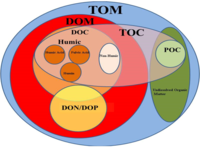
Photo from wikipedia
Abstract Gas storage in shale (organic-rich mudstone) consists of three different states: free gas in pores and natural fractures; adsorbed gas on organic and inorganic pore walls; and absorbed gas… Click to show full abstract
Abstract Gas storage in shale (organic-rich mudstone) consists of three different states: free gas in pores and natural fractures; adsorbed gas on organic and inorganic pore walls; and absorbed gas into organic matter (kerogen). Since it is difficult to differentiate absorbed gas from adsorbed gas, most current studies combine the adsorbed gas with absorbed gas and call the combination as gas sorption. In this study, a conceptual model of gas sorption is proposed to account for the contributions from adsorption and absorption to gas storage in shale, respectively. Methane sorption capacity of Barnett and Eagle Ford shale core samples is measured by magnetic suspension sorption system. Regression analysis is performed on the measured data by Simplified Local-Density model coupled with modified Peng-Robinson Equation of State (SLD-PR). Absolute sorption capacity of these two shale core samples is estimated based on the density profile of SLD-PR model. Additionally, the absorbed gas, which is regarded as the gas molecules dissolving/diffusing into the bulk of solid kerogen, is distinguished from the adsorbed gas through interpreting the results of gas expansion measurements using Fick’s law of diffusion. Moreover, methane diffusion coefficients for the two shale core samples are determined, which range from 10−22 m2/s to 10−21 m2/s. The percentage of absorbed gas accounting for total sorbed gas increases with pore pressure. When the pore pressure increases, more gas molecules attempt to adsorb on the surface of kerogen and create a larger gas concentration gradient for gas diffusing into the kerogen. The gas molecules, which adsorb on the pore walls of kerogen and then diffuse into the solid lattice of kerogen, may lead to the swelling of kerogen and thus reduce the pore width for free gas transportation. Therefore, the accurate prediction of the gas absorption capacity of kerogen is significant to understand gas storage mechanism and characterize original gas in place (OGIP) in shale gas reservoirs.
Journal Title: Fuel
Year Published: 2019
Link to full text (if available)
Share on Social Media: Sign Up to like & get
recommendations!